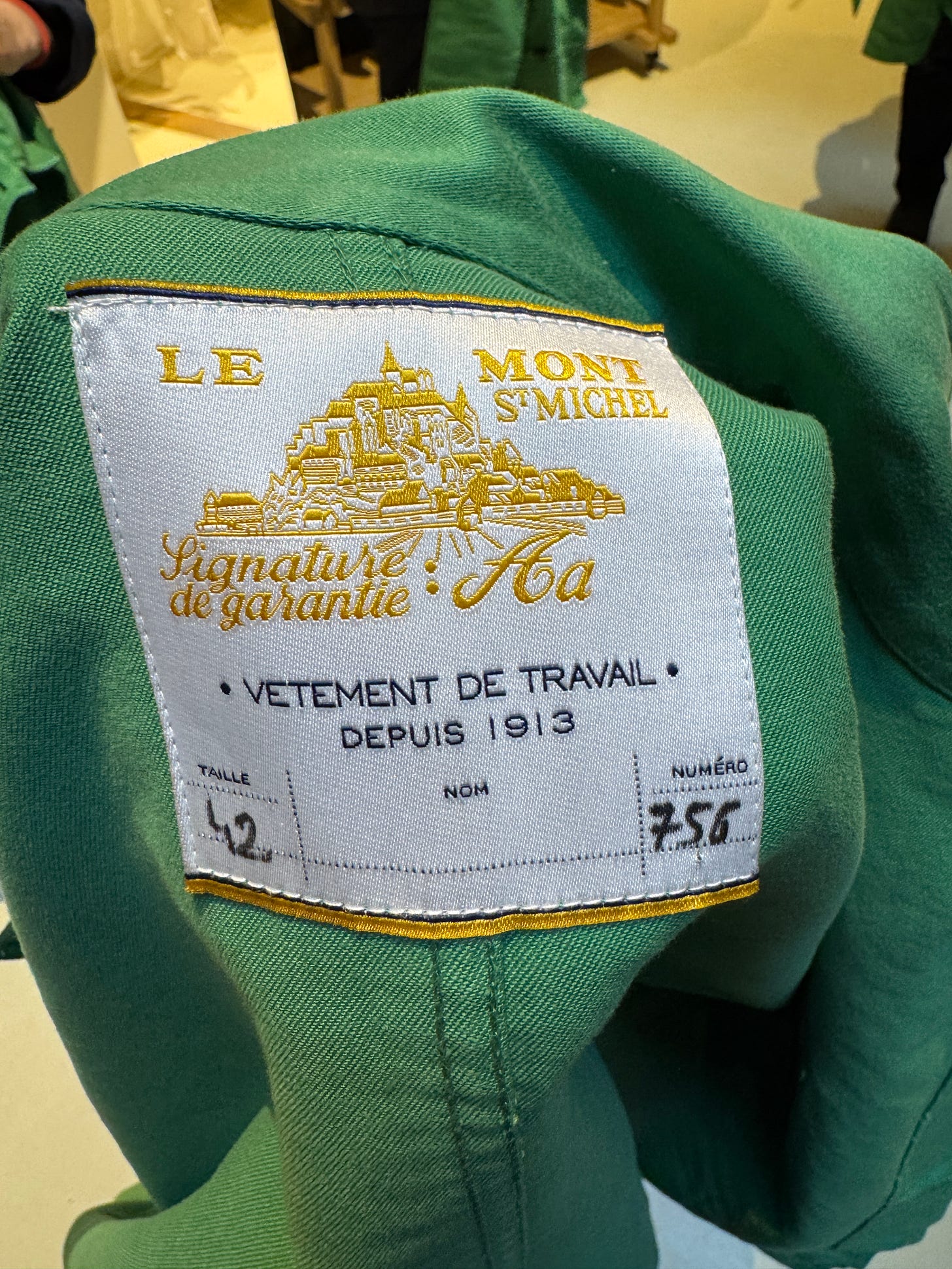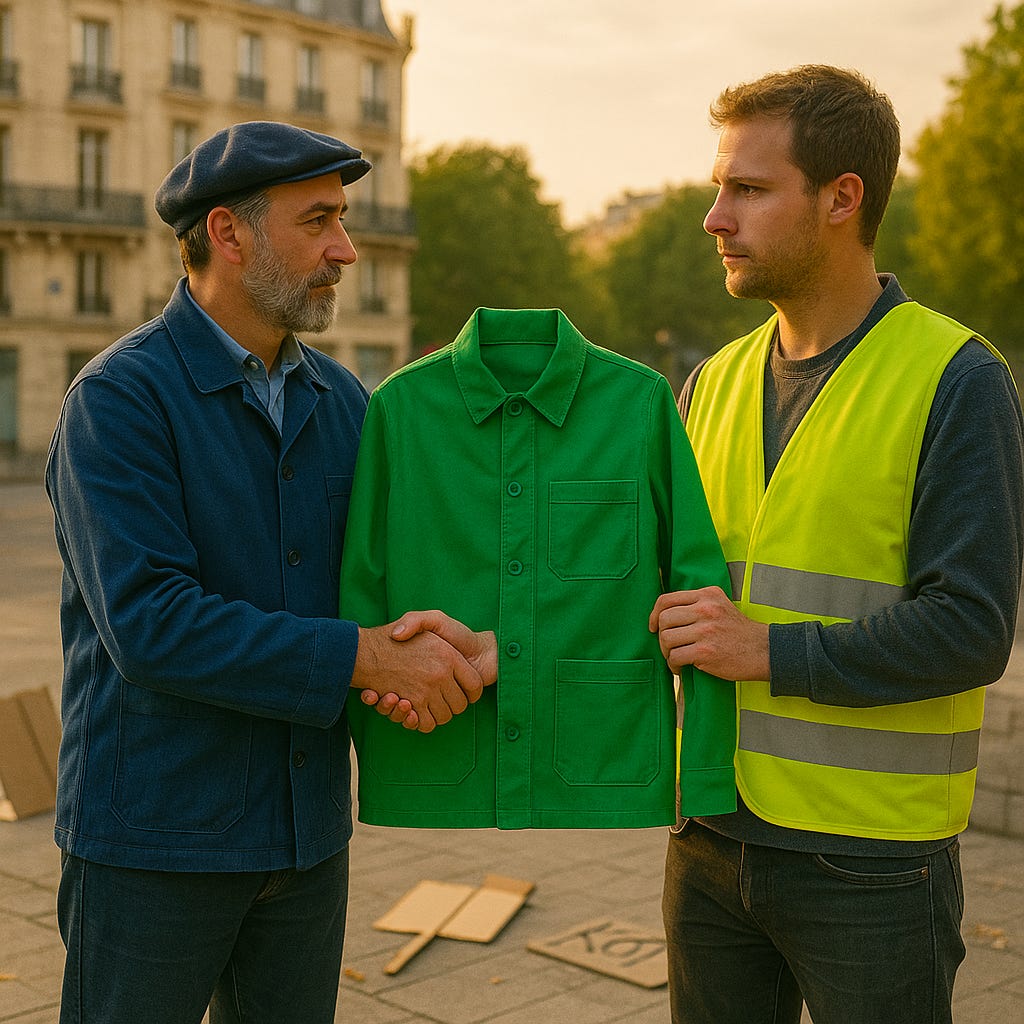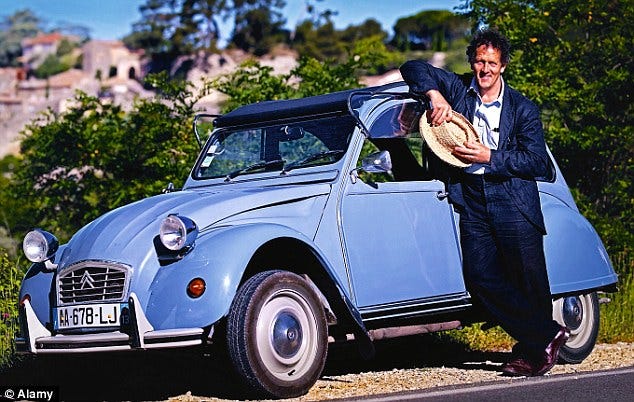#9 Meditations on a Jacket
Paynter, Le Mont Saint Michel, and the iresistible rise of the worker's jacket
My name is Louis Elton. I’m on a quest to craft an entire outfit from underwear-to-outerwear entirely in Britain. Why? To trigger a renaissance in British manufacturing and to heal the nation’s spirit, of course! In this week’s post, I go on a digression into the lore, iconicity, and influence of the French worker’s jacket and what it means for Nation of Artisans. TL;DR: there’s hand crafted memes, case studies of Paynter & Mont Saint Michel, and speculative counterfactual histories of the rise of gilet jaunes protests.
For the last few years, I have been closely monitoring the rise of the worker’s jacket. First adopted by the East London people, now the Clapham people are quickly following jacket.
Each paradigm of affluence is symbolised by an item of clothing. The Yuppies had the suit and contrast collar shirt. The Creative Class / Bobos had the white trainer. In the emerging Age of the Bopea, it’s the worker’s jacket.
1. The Bopea Supreme
Nation of Artisans’ “slow" business model is partially inspired by one particular purveyor of worker’s jackets: the Paynter Jacket Company. Founded in 2018 by Becky Okell and Huw Thomas, Paynter committed early to a simple but compelling idea — release four limited runs of meticulously made chore coats each year and build a loyal community through a newsletter. It’s a sort of Bopea Supreme.
Brands are obsessed with the idea of community. Yet, if a brand calls itself a community, it probably isn’t. Most “brand communities” are generally spiritually bankrupt marketing schemes sparked by reductive MBA case studies that say “line go up if community is KPI → because lifetime customer value > customer acquisition cost.”
Most big brands have no interest in making the trade offs required to build real bonds. The urge for scale is at odds with the deep webs needed to forge genuine connection.
Yet 7 years in, Paynter has actually done it. Their stans are truly obsessed. To the initiated, Paynter is a cipher for a uniquely rooted, humane consumer mindset. Everything sells out in minutes. No waste. No expensive marketing overheads. No wear-once-and-discard. Just pure, small-scale community-bonded consumption. Paynter is the anti-Shein.
It’s a wonderful model for the future of culture and consumption. A Nation of micro-shopkeepers leveraging deep storytelling to a niche audiences, enchanted with layers and layers of thought and delight. From their labels and to little gifts — Paynter puts love into everything they do.
I would love to eventually make a Nation of Artisans film about Paynter.
2. French Worker’s Jackets
And yet, despite my love for Paynter, I don’t own one. Why? Short answer: I’m picky and I can’t get one of their jackets in the exact shade of emerald green I crave. Long answer: I fell for another jacket — one that sent me on a field trip to France.
Worker’s jackets are often known as “French workers’ jackets”. These jackets were originally made for early 20th century farm hands and artisans. By the 1950s, the distinctive “bleu de travail” became standard issue workwear for mechanics and factory workers due to durability, protective mole-skin, and large pockets for tools.
Some French labour unions then successfully campaigned for employers to supply some workers with fresh jackets annually. Supposedly this is why vintage markets are flooded with them — manufacturers simply had to make so many — and they last forever.
In the 70 years since, the jacket has slowly taken over. From Harry Styles to Monty Don — it has quietly become an icon.
There are several major workers’ jacket brands in France including A l'Ouvrier (1905), Vetra (1927), Le Laboureur (1956). However, it is only Le Mont Saint Michel who make it in the exact shade of emerald green (not blue) that I am maniacally obsessed with.

Named after the actual Mont Saint Michel from where it hails in Brittany, the brand was founded in 1913. After a hiatus, the brand was revived in the 1990s by Alexandre Milan.
The manufacturing still happens in a small workshops in Brittany. While the brand has expanded beyond the archetypal indigo-blues, they are still made in the same way using a robust cotton moleskin that develops a patina with age.
3. A Boutique Adventure
Ever since seeing one in the flesh for the first time — I have lusted after one of Le Mont Saint Michel’s emerald green numbers. They cost a fortune to import into the UK and I have not had the opportunity in Paris since I first came across them.
A few weeks ago, the moment finally presented itself, so I went on a pilgrimage to their boutique on the Rue Vielle du Temple in the Marais in the 3rd Arrondissement.
The shop:
I went in and darted to the green jacket of my dreams.
I tried it on. Then had a moment of doubt: the jacket’s large buttons coming into conflict with my very particular version of koumpounophobia (fear of buttons).
Then, the shop assistant successfully flattered me into buying it insisting “my boss has the exact same jacket and everyone comments ‘Madame you look amazing’”. Like most men, I too wish to look like a chic Parisian lady.
It’s a delightful piece. Particularly endearing is the hand written numbering of each jacket — I am now the proud owner of the 756th emerald green jacket. The more mainstream colours go a lot higher.
An Interlude: France, Workers & Jackets
Is it not fascinating that France’s workers have come to be defined by not one, but two, worker’s jackets?
A stupid thought: Had Emmanuel Macron had sold his fuel taxes as part of a green industrial revolution where everyone got beautiful green worker’s jackets instead of austerity — then maybe the gilets jaunes would not have turned on him.
4. Lessons for Nation of Artisans
The stories of Paynter and Le Mont Saint Michel reveal a shared truth: making beautiful, storied things with integrity is good business. Whether you’re a 7-year-old startup or a 112-year-old atelier, the demand is there. And in the Bopea era, I think that demand will continue to grow.
To channel this spirit into Nation of Artisans, there are some principles I will follow:
Culture, not Cool: Cool fades. Culture endures. Community, mythos, and passion outlast virality. That’s the key to timelessness.
Details Matter: It’s the little things. Le Mont Saint Michel’s handwritten jacket numbers spark delight. Paynter’s little gifts and stories are just as much part of the product as the jackets themselves.
Craft: Longevity enables devotion. As obvious as it sounds, make things properly with durable materials — people can’t fall in love with stuff if it breaks in a couple of years.
5. What else is going on in NoA?
For the next couple of weeks, I’m travelling around North America for work (and pleasure!)
The Nation of Artisans’ Design Prize submission has now closed. I received some beautiful entries — judging and selection will soon begin!
I’m going to make some Nation of Artisans Make Britain Make Again caps. Who wants one?
I ordered a very mythic and strange item of clothing that will be the subject of a short film in the next few months.
Now please hit that ❤️ button at the bottom and share with all of your friends so the Substack algorithm is kind to me.
Until next time.













So, tell us more about Koumpounophobia. As a type of phobia, does this extend to other types of clothing features? Or is this a tactic cunningly used by small boys to refuse their parents' demands that they must wear smart clothes. I have my darkest suspicions and look forward to being convinced that this really is a Thing.
Look at ventile - fabulous cloth, water repellent by construction - very functional, smooth, durable (military uses) and is more lovely in a jacket - could very well be your fabric product of the lot here.